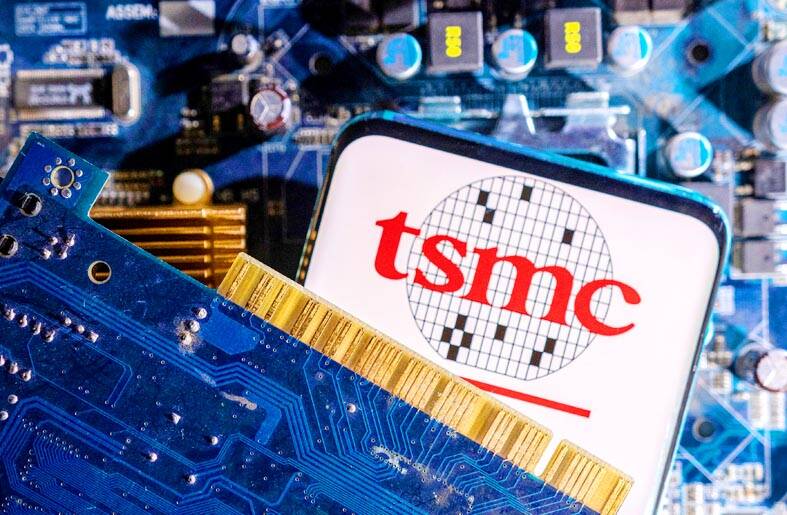Taiwan Semiconductor Manufacturing Co (TSMC, 台積電) plans to invest NT$90 billion (US$2.9 billion) to expand its advanced chip packaging capacity in Miaoli County’s Tongluo Science Park (銅鑼科學園區) to cope with customer demand, the world’s largest contract chipmaker said yesterday.
The Hsinchu Science Park Bureau has approved its application to lease land at the Tongluo Science Park, a branch campus of the Hsinchu Science Park (新竹科學園區), for the plant’s construction, the chipmaker said in a statement.
TSMC did not elaborate on the project, including the time frame for its operation, saying only that the investment would create 1,500 job opportunities.

Photo: Reuters
The new investment comes as the chipmaker is having difficulty supplying advanced packaging capacity, especially 3D packaging technology and chip-on-wafer-on-substrate (CoWoS) technology, thanks to robust demand for artificial intelligence (AI) chips.
With its leading-edge process technologies, TSMC makes the AI GPU H100 for Nvidia Corp and MI300 GPU for Advanced Micro Devices Inc.
“We cannot fulfill 100 percent of customers’ needs,” TSMC chief executive officer C.C.Wei (魏哲家) told investors on Thursday last week. “We are increasing capacity as quickly as possible.”
The chipmaker plans to double its CoWoS capacity, Wei added, expecting the supply crunch to ease up at the end of next year.
TSMC has said it plans to allocate a small fraction of its capital expenditure budget of US$32 billion to US$36 billion this year to packaging.
A big chunk of the budget would go into the development of leading-edge technologies, including 3-nanometer and 2-nanometer processes, it said.
In addition to pure wafer foundry operations, TSMC operates five advanced chip packaging plants in Taiwan: at Hsinchu Science Park, Taoyuan’s Longtan District (龍潭), Miaoli County’s Jhunan Township (竹南), Central Taiwan Science Park (中部科學園區) in Taichung and the Southern Taiwan Science Park (南部科學園區) in Tainan.
Separately, TSMC said it is taking routine precautionary measures at all its fabs across the nation as Typhoon Doksuri approached Taiwan.
These include “24-hour on-duty personnel and emergency response teams, including water, electricity, mechanical and disaster recovery experts,” the chipmaker said in an e-mailed response to inquiries.
Other measures include inspections of drainage systems and waterproof gates; carrying out pump inventory testing; and minimizing use of temporary installations exposed to strong winds, TSMC said.
Additional reporting by Bloomberg

The combined effect of the monsoon, the outer rim of Typhoon Fengshen and a low-pressure system is expected to bring significant rainfall this week to various parts of the nation, the Central Weather Administration (CWA) said. The heaviest rain is expected to occur today and tomorrow, with torrential rain expected in Keelung’s north coast, Yilan and the mountainous regions of Taipei and New Taipei City, the CWA said. Rivers could rise rapidly, and residents should stay away from riverbanks and avoid going to the mountains or engaging in water activities, it said. Scattered showers are expected today in central and

COOPERATION: Taiwan is aligning closely with US strategic objectives on various matters, including China’s rare earths restrictions, the Ministry of Foreign Affairs said Taiwan could deal with China’s tightened export controls on rare earth metals by turning to “urban mining,” a researcher said yesterday. Rare earth metals, which are used in semiconductors and other electronic components, could be recovered from industrial or electronic waste to reduce reliance on imports, National Cheng Kung University Department of Resources Engineering professor Lee Cheng-han (李政翰) said. Despite their name, rare earth elements are not actually rare — their abundance in the Earth’s crust is relatively high, but they are dispersed, making extraction and refining energy-intensive and environmentally damaging, he said, adding that many countries have opted to

People can preregister to receive their NT$10,000 (US$325) cash distributed from the central government on Nov. 5 after President William Lai (賴清德) yesterday signed the Special Budget for Strengthening Economic, Social and National Security Resilience, the Executive Yuan told a news conference last night. The special budget, passed by the Legislative Yuan on Friday last week with a cash handout budget of NT$236 billion, was officially submitted to the Executive Yuan and the Presidential Office yesterday afternoon. People can register through the official Web site at https://10000.gov.tw to have the funds deposited into their bank accounts, withdraw the funds at automated teller

CONCESSION: A Shin Kong official said that the firm was ‘willing to contribute’ to the nation, as the move would enable Nvidia Crop to build its headquarters in Taiwan Shin Kong Life Insurance Co (新光人壽) yesterday said it would relinquish land-use rights, or known as surface rights, for two plots in Taipei’s Beitou District (北投), paving the way for Nvidia Corp to expand its office footprint in Taiwan. The insurer said it made the decision “in the interest of the nation’s greater good” and would not seek compensation from taxpayers for potential future losses, calling the move a gesture to resolve a months-long impasse among the insurer, the Taipei City Government and the US chip giant. “The decision was made on the condition that the Taipei City Government reimburses the related